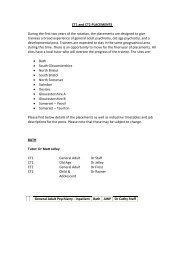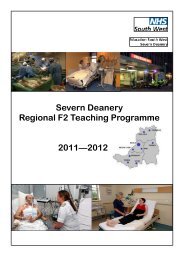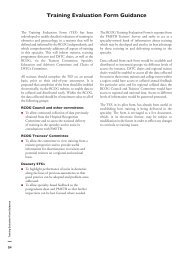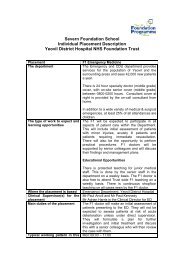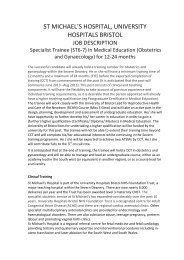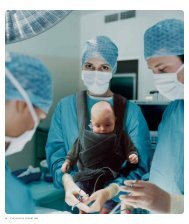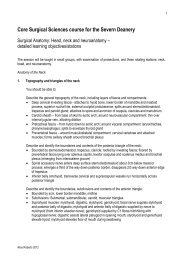Abdomen and Pelvis objectives - Surgery - Severn Deanery
Abdomen and Pelvis objectives - Surgery - Severn Deanery
Abdomen and Pelvis objectives - Surgery - Severn Deanery
You also want an ePaper? Increase the reach of your titles
YUMPU automatically turns print PDFs into web optimized ePapers that Google loves.
2<br />
<br />
<br />
<br />
External iliac artery forms principal supply to lower limb<br />
Internal iliac artery supplies pelvic viscera, walls <strong>and</strong> gluteal region<br />
common iliac <strong>and</strong> gonadal arteries<br />
IVC <strong>and</strong> its tributaries: common iliac, gonadal, renal <strong>and</strong> hepatic veins.<br />
Branches of the lumbar plexus emerging around <strong>and</strong> through psoas: subcostal, ilioinguinal <strong>and</strong><br />
iliohypogastric, genitofemoral, lateral femoral cutaneous, femoral, obturator nerves <strong>and</strong> the lumbosacral<br />
trunk.<br />
You should be able to describe <strong>and</strong> identify the kidneys:<br />
Position <strong>and</strong> relations of the kidneys: extend from T12 to L3 with the hila at the level of L1; lie 3<br />
finger breadths from the midline; right kidney slightly lower than the left<br />
The three ‘capsules’ of the kidney (fibrous capsule; perinephric fat; renal/extraperitoneal fascia)<br />
Posterior relations of each kidney (diaphragm, 12 th rib, quadratus lumborum, psoas, transversus<br />
abdominis; subcostal, iliohypogastric, ilioinguinal nerves)<br />
Anterior relations of the right kidney (suprarenal gl<strong>and</strong>, liver, 2 nd part of duodenum, ascending<br />
colon) <strong>and</strong> left kidney (suprarenal gl<strong>and</strong>, stomach, pancreas, spleen, descending colon)<br />
You should be able to describe <strong>and</strong> identify the suprarenal gl<strong>and</strong>s:<br />
Right adrenal gl<strong>and</strong> lies posterior to liver; left lies posterior to stomach <strong>and</strong> pancreas; both lie within<br />
the coverings of the perinephric fat <strong>and</strong> renal fascia<br />
Structure: outer cortex <strong>and</strong> inner medulla<br />
Right adrenal gl<strong>and</strong> is pyramidal; left is crescent-shaped <strong>and</strong> larger)<br />
Supplied by inferior phrenic arteries, aorta <strong>and</strong> renal arteries;<br />
You should be able to describe the external appearance <strong>and</strong> internal architecture of the kidneys:<br />
poles, hilum (order of structures entering/exiting)<br />
cortex; medullary pyramids; major <strong>and</strong> minor calyces; renal pelvis <strong>and</strong> hilum of the kidney<br />
lymph from the kidney drains to para-aortic nodes<br />
sympathetic innervation via renal plexus; afferents enter the spinal cord in the tenth, eleventh <strong>and</strong><br />
twelth thoracic nerves<br />
You should be able to discuss how <strong>and</strong> why an intravenous urogram (IVU) may be obtained, <strong>and</strong> the<br />
appearance of common problems on the IVU (eg: cystic or neoplastic disease may be seen, reduced<br />
renal blood flow, obstruction, bladder filling defects <strong>and</strong> emptying). There are three constrictions along<br />
the course of the ureter: pelvi-ureteric junction (PUJ), pelvic brim, vesico-ureteric junction (VUJ)<br />
You should underst<strong>and</strong> the anatomical basis of renal clinical problems, including:<br />
Developmental anomalies (polycystic kidneys, horseshoe kidney, duplication of the ureter, ectopic<br />
ureters, pelvic kidney)<br />
Urinary tract calculi – complications <strong>and</strong> treatment<br />
Referred pain from the kidney produces typical ‘loin to groin’ pain: visceral afferents in the least<br />
splanchnic nerve enter the spinal cord at T12, so pain is referred to T12 dermatome, corresponding<br />
to the flanks <strong>and</strong> pubic region.<br />
Alice Roberts 2012



